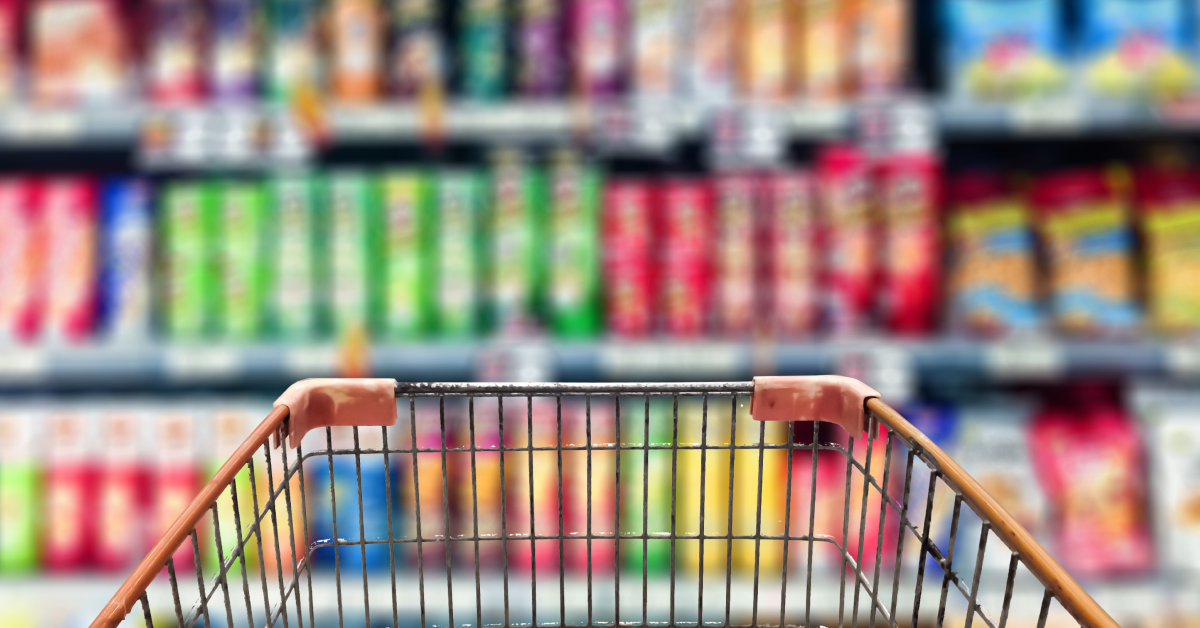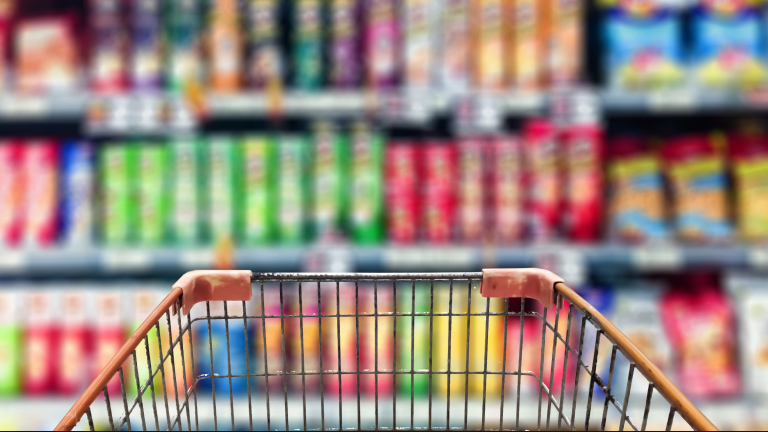Just how bad are ultra-processed foods?


If you’re a semi online person, then you may have noticed that there’s a new moral panic over what’s okay/not okay to eat nearly every day. One moment, everyone is all on board for plant-based diets. The next, you’re watching “nutrition” influencers season a slab of beef for breakfast. And the message that’s permeating culture loud and clear right now is that something called ultra-processed foods are absolutely terrible. But what are ultra-processed foods? What “counts” as one, and what effect do they have on our health? We looked beyond the headlines for actual experts and actual science. Here’s what we found.
What are ultra-processed foods?
Unless you’re plucking a tomato off of a plant in your backyard and taking a big bite, most foods you eat are processed to some extent, says New York City-based registered dietitian Nicole Rodriguez, RDN. That might include chopping, canning, or drying, for example. But some foods get the processing treatment more than others, and these fall into the category of ultra-processed foods.
According to the NOVA classification system, a framework which food scientists and public health officials use to define different levels of processing, a food falls into the ultra-processed food (UPF) category if it includes an ingredient that is never/rarely used in the kitchen or contains an additive to make the food more appealing. For example:
- Colors
- Emulsifiers
- Flavors
- High-fructose corn syrup
- Hydrogenated oils
- Hydrolysed proteins
- Sweeteners
- Thickeners
These ingredients aren’t rare, and neither are the foods they’re used in — your grocery store is packed with them. Beyond sharing these additives, one thing all ultra-processed foods have in common is that “they’ve gone through a series of processing to include, in the end, very few intact [or whole] foods,” says Christie Sauer, M.S., RDN, a registered dietitian with WeightWatchers. Unlike, say, an apple with a swipe of peanut butter, ultra-processed foods are “highly modified from their original form.” Below are some foods that are usually considered ultra-processed. Use this as a guide to help you identify UPFs while you shop:
- Breakfast cereals
- Cake mixes
- Candy
- Chicken nuggets and fish sticks
- Cookies and pastries
- Energy bars
- Energy drinks
- Ice cream
- Instant soup
- Margarine
- Meal replacement shakes and powders
- Packaged breads and buns
- Packaged snacks (chips, crackers, snack mixes, sweet snacks)
- Pre-prepared pasta and pizza
- Sausages and hot dogs
- Soda and other sugar-sweetened beverages
- Sweetened yogurt
So what’s the problem with ultra-processed foods?
A single food by itself is unlikely to cause issues in your diet. The problem is that UPFs are ubiquitous both in our environment and in our diets. In fact, about 70% of the U.S. food supply is made up of UPFs. And that’s made it all too easy for us to eat more. Americans’ intake of ultra-processed foods has mushroomed over the past two decades; today 57% of our calories come from these foods, while our consumption of minimally processed foods (more “whole” foods) has declined, according to data in the The American Journal of Clinical Nutrition.
Unfortunately, that’s a problem. “Ultra-processed foods tend to be higher in calories, saturated fat, added sugar, and sodium. They also tend to be lower in fiber and protein, two nutrients that help us feel full,” says Sauer. “Altogether, UPFs can lead to greater amounts of calories consumed and potentially less fiber and protein consumed.”
This could promote obesity — a disease associated with excessive fat accumulation that raises health risks across the board — since getting a higher percentage of calories in your diet from ultra-processed foods is linked to weight gain, points out a trial published in the journal Nutrients. Compared to less processed foods, we tend to eat larger portions of UPFs, as they’re both hyperpalatable and convenient. The study authors also note that some of their additives may also disrupt our gut health and promote inflammation, which may also contribute to obesity. What’s more, if we’re eating more of these, we have less room for fruits and veggies, two types of foods that are high in volume and fiber and low in calories and have been linked to weight loss.
That’s a problem across the day, says Rodriguez: “When we’re too dependent on ultra-processed foods being the staple in our diets, they’re likely displacing foods that are more nutrient-dense.” If you grab a packaged muffin for breakfast or fast food for lunch, then you likely don’t have a big capacity for much else.
Another problem? UPFs are easier to chew. (Picture a piece of soft white bread versus a hearty multigrain. Or pretzels versus nuts or carrots.) A very small randomized controlled trial (on just nine people) found that those eating UPFs had a significantly lower number of chews per calorie compared to a period when they ate non-UPFs. Plus, they consumed about 814 calories more per day when eating UPFs.
There are reasons beyond weight loss and management to give a critical eye to the ultra-processed foods in your diet. Top among them: Your heart health. In a meta-analysis of 22 studies, people who consumed the highest amount of UPFs had a 17% and 9% increased risk of developing cardiovascular disease and stroke compared to the lowest group. Diets rich in UPFs have also been linked to higher odds of overall mortality, type 2 diabetes, anxiety, and depression. Though in the same meta-analysis of 22 studies some categories of UPFs — namely bread/cold cereals, yogurt/dairy, and savoury snacks — an inverse relationship between UPF consumption and risk of cardiovascular disease was seen.
One important caveat: UPFs can be part of a healthy diet. Some of these foods often contain important nutrients, such as less processed carbohydrates (e.g. whole wheat flour), lean protein, healthy fats, and vitamins and minerals that can support your health, according to one study in The Journal of Nutrition. It does take a lot of planning, but researchers were able to create a healthy and nutritious menu based on mostly ultra-processed foods. Some of those foods included liquid egg whites, shredded cheese, instant oatmeal, cold cereal, bread, deli meat, and flavored yogurt — foods that may support weight loss. That doesn’t mean you should only eat UPFs, but it does mean that some of these can fit, provided they’re helpful in helping you stick to a healthy diet pattern, are cost-effective for you, and you find them enjoyable.
How much is too much UPFs?
UPFs are easy to buy, convenient, and often cheaper in cost. And you don’t have to completely shut them out of your life. “In the WeightWatchers program, we always say that all foods can fit,” says Sauer. She encourages people to eat fruits, vegetables, and lean proteins most of the time, rounding out meals with whole grains and healthy fats. The WeightWatchers Points Program can be helpful here, as it’s designed to guide you towards more nutrient-rich foods and healthy portions without excluding anything. To scale back on the UPFs on your plate, follow these three tips:
Plan ahead: When you’re hungry and in a pinch, you’ll be more apt to reach for convenience foods, which are often ultra-processed in nature. Planning ahead — like deciding on a healthy menu for the week and shopping for it — will get a lot of the work out of the way. “When you know the meals you want to eat and have ingredients on hand, you’re less likely to turn to UPFs when in a time crunch,” says Sauer. Some simple meal prepping can turn whole foods into convenience foods.
Make simple swaps: Some UPFs may be staples in your diet, but you can easily trade them for more whole foods — many of which are ZeroPoint® foods on the WeightWatchers Program, says Sauer. For example, rather than flavored sweetened yogurt, choose plain, fat-free Greek yogurt and add chopped fruit on your own. Instead of a sugary cereal, have oatmeal. “These small choices add up over time,” she says.
Practice pairings: Grabbing a UPF? Combo it with a whole food, suggests Rodriguez. For example, if you’re having a frozen pizza for dinner, serve it with a fresh salad made with spinach and tomatoes. Or top a bowl of cottage cheese and fresh berries with some cereal. “If that cereal is giving me vitamins and making a habit of cottage cheese and fruit more palatable, I think that’s a net win,” she says.
The bottom line
Most foods undergo some level of processing, but ultraprocessed foods are so processed they bear little resemblance to their original form. They contain ingredients you’d rarely find in a kitchen — such as artificial colors, emulsifiers, and flavors — and are often found in packaged goods like breakfast cereals, cake mixes, sweetened yogurt, and much more. They are everywhere in our food environment and our diets, and this poses a public and personal health threat: most UPFs are higher in calories and lower in nutrients like protein and fiber that keep us full, likely leading to weight gain and an uptick in weight-related health risks. While it isn’t necessary to eliminate them from your diet entirely, experts do recommend cutting back on the volume of ultra-processed foods you’re eating.
This content is for informational purposes only and does not constitute medical advice, diagnosis or treatment. It should not be regarded as a substitute for guidance from your healthcare provider.
What are processed foods: Harvard T.H. Chan School of Public Health. (2023). “Processed Foods and Health.”
https://nutritionsource.hsph.harvard.edu/processed-foods/
https://www.cambridge.org/core/journals/public-health-nutrition/article/ultraprocessed-foods-what-they-are-and-how-to-identify-them/E6D744D714B1FF09D5BCA3E74D53A185
https://www.mdpi.com/2072-6643/11/8/1704
https://pubmed.ncbi.nlm.nih.gov/34647997/
https://www.mdpi.com/2072-6643/17/4/638
https://pubmed.ncbi.nlm.nih.gov/39267249/
https://pmc.ncbi.nlm.nih.gov/articles/PMC7399879/
https://www.sciencedirect.com/science/article/pii/S2667193X24001868
https://www.bmj.com/content/384/bmj-2023-077310
https://www.sciencedirect.com/science/article/pii/S0022316623724346
